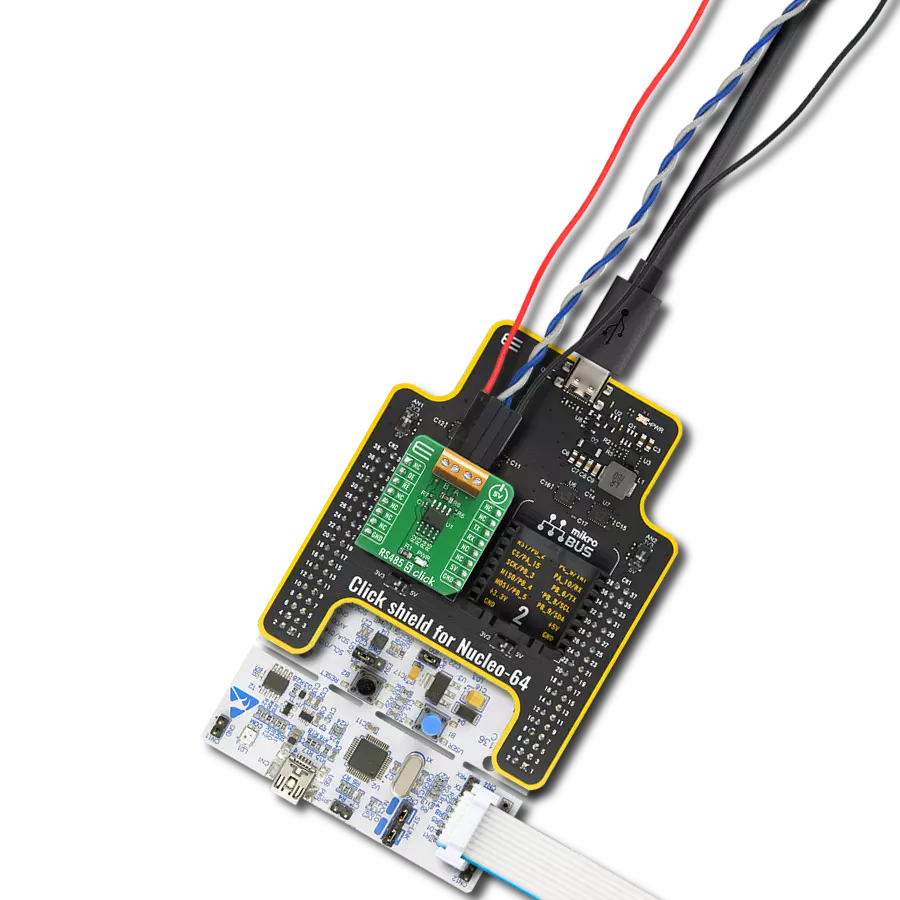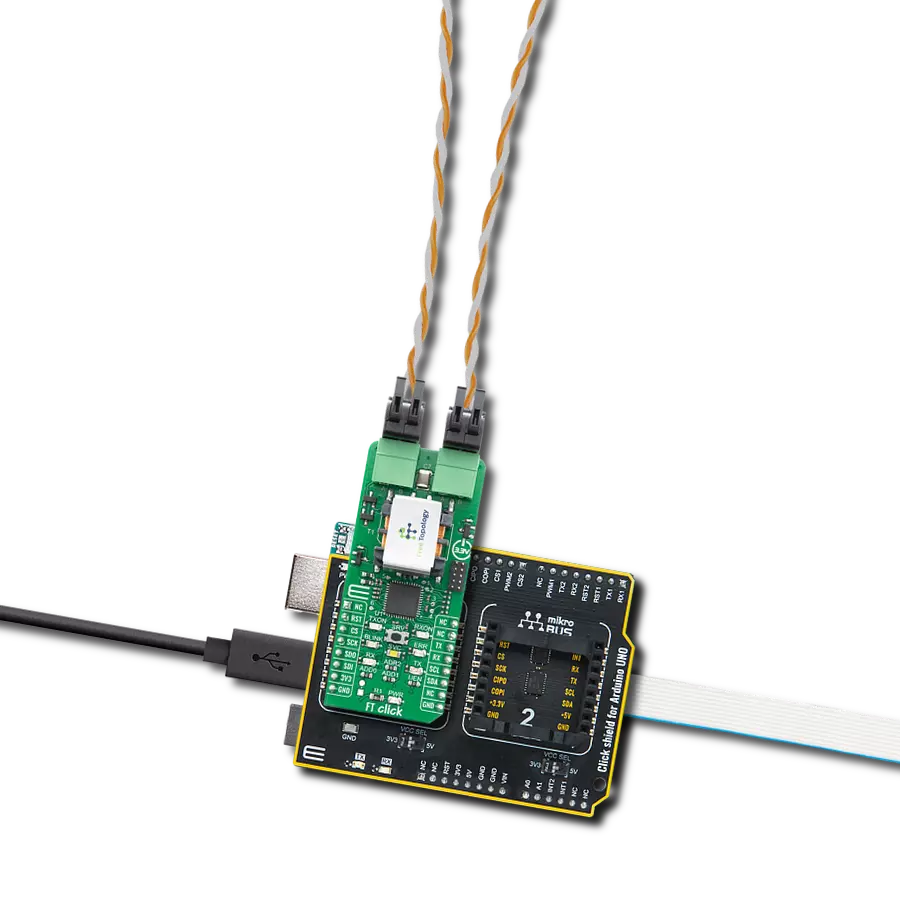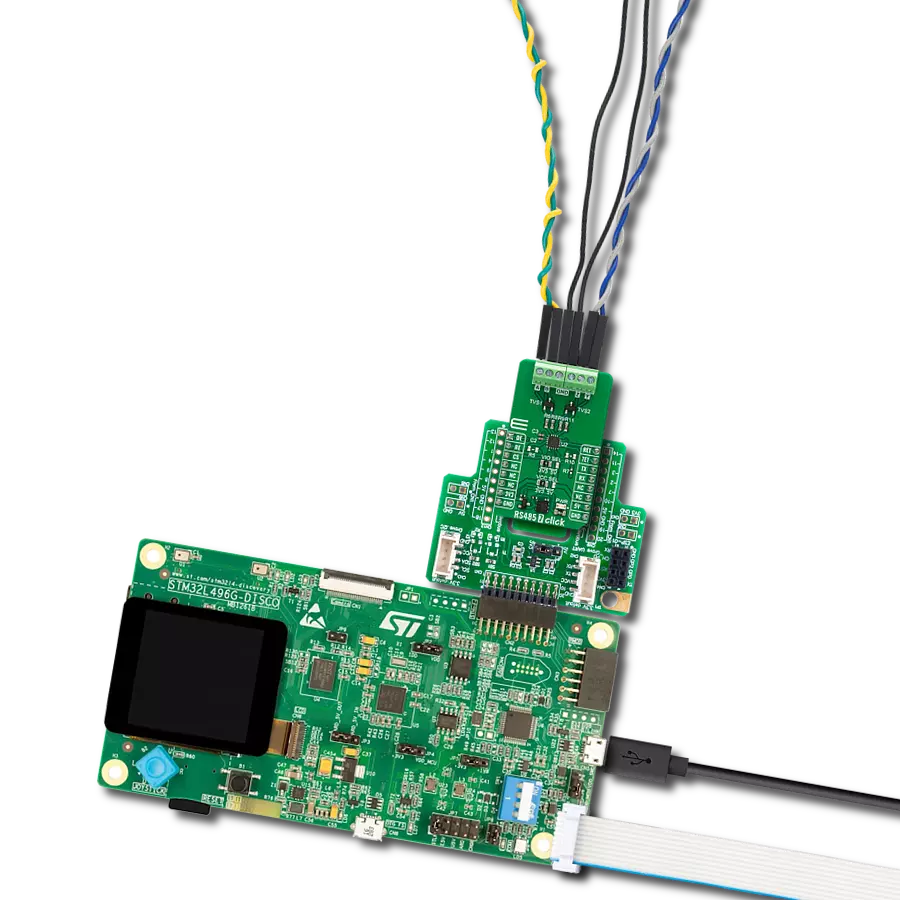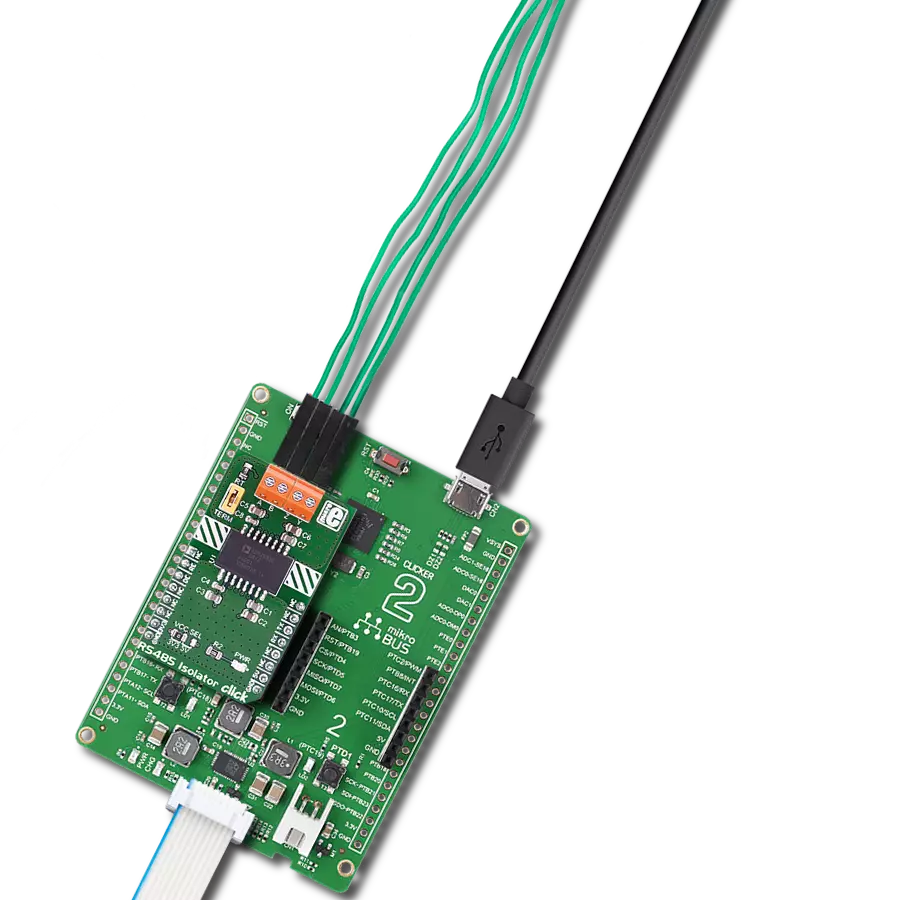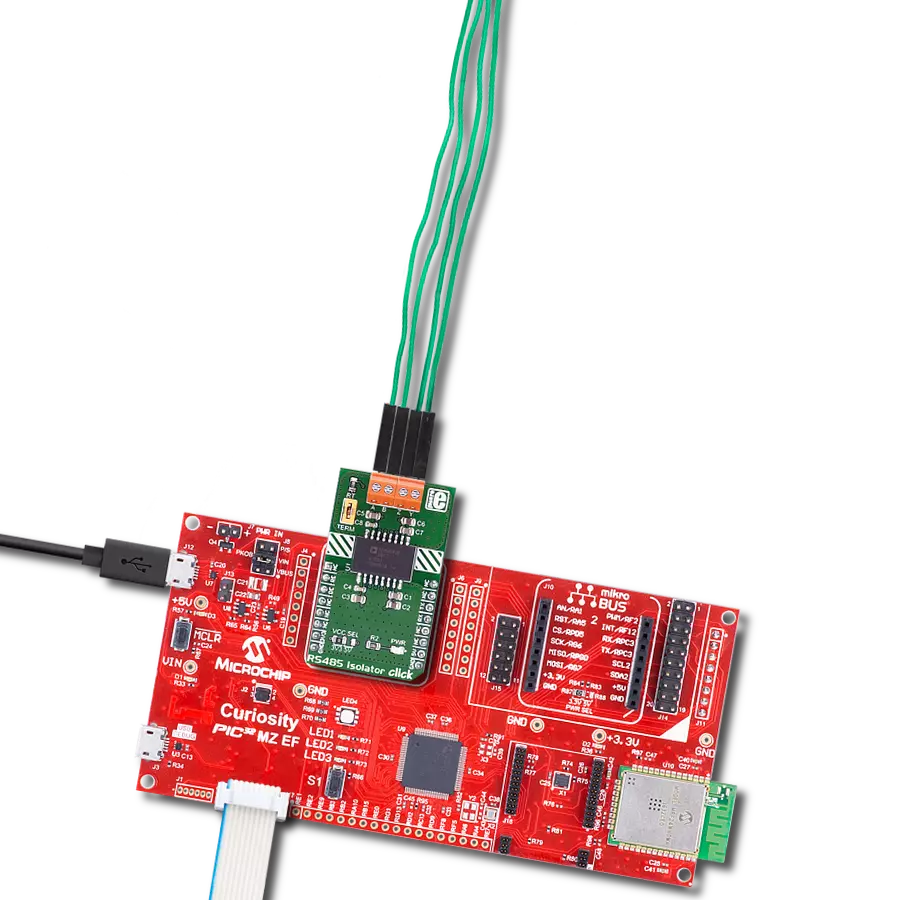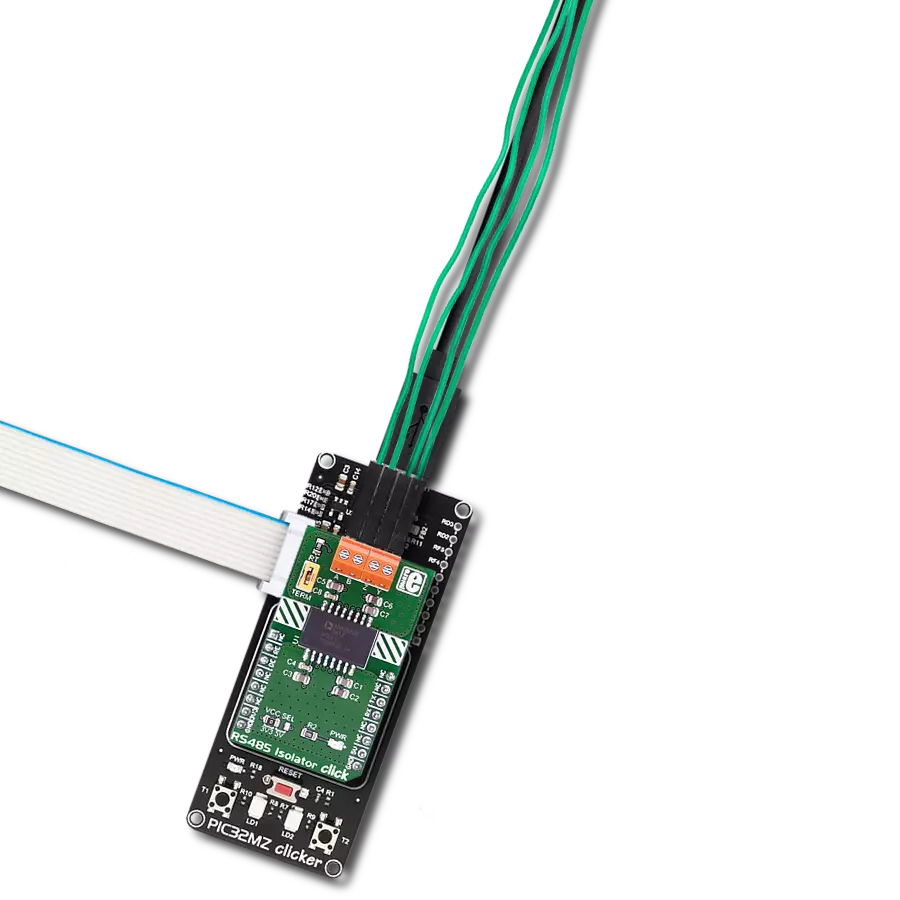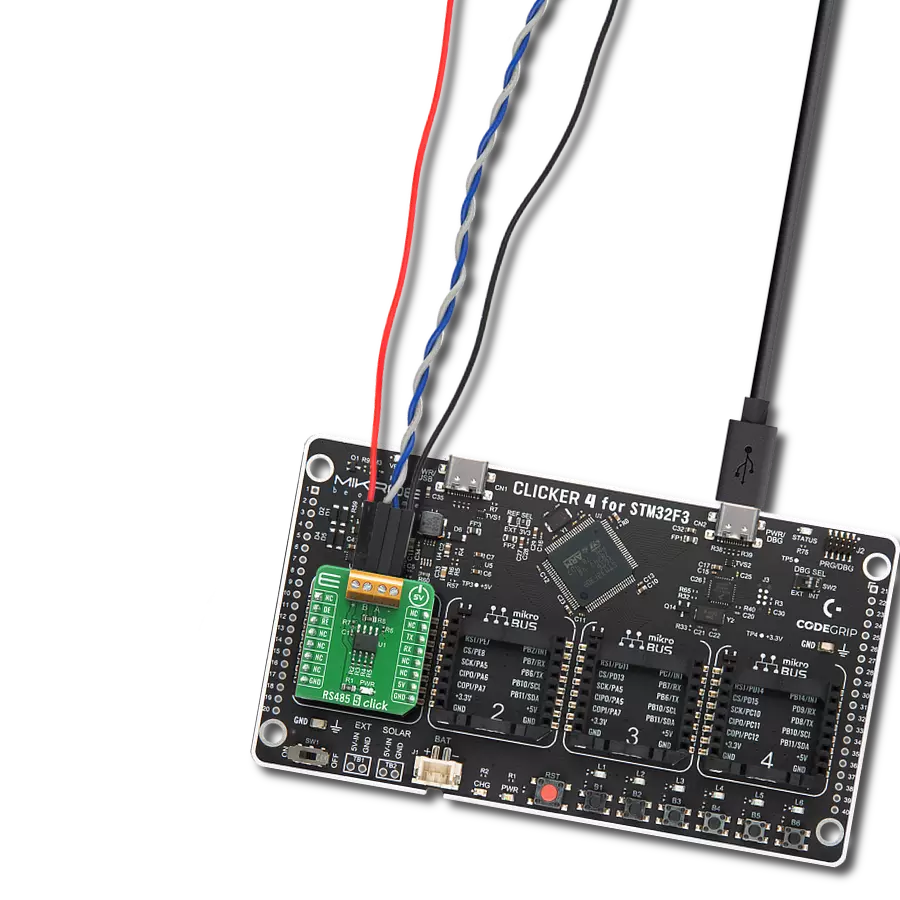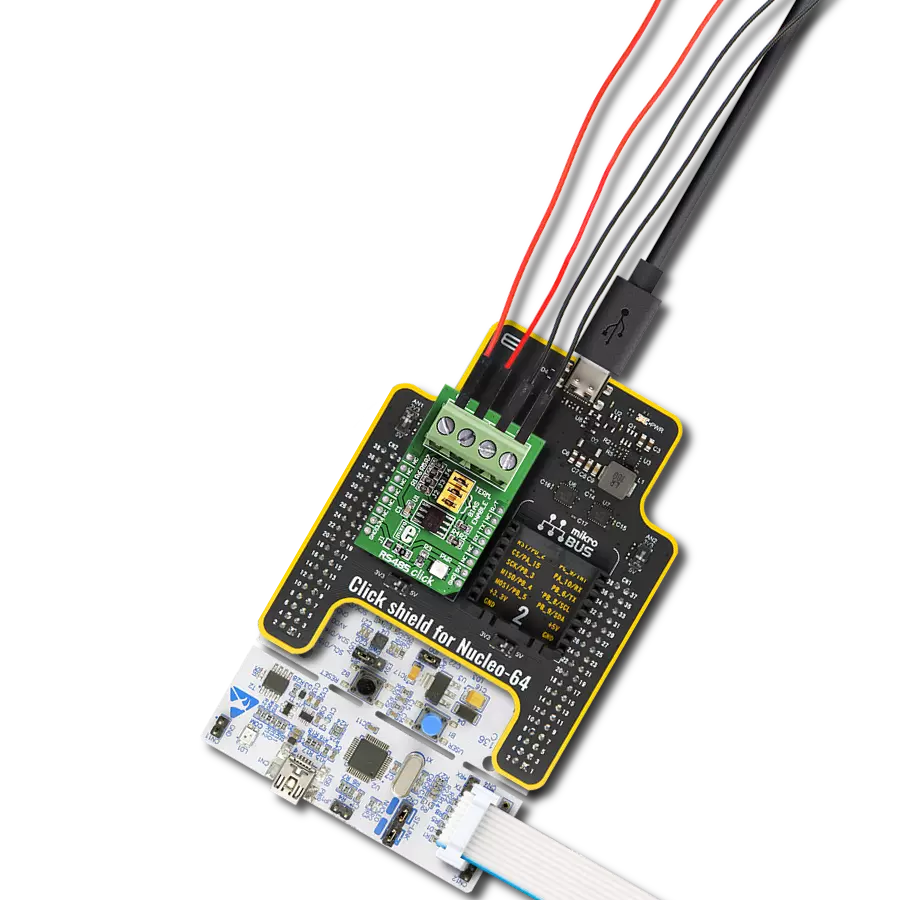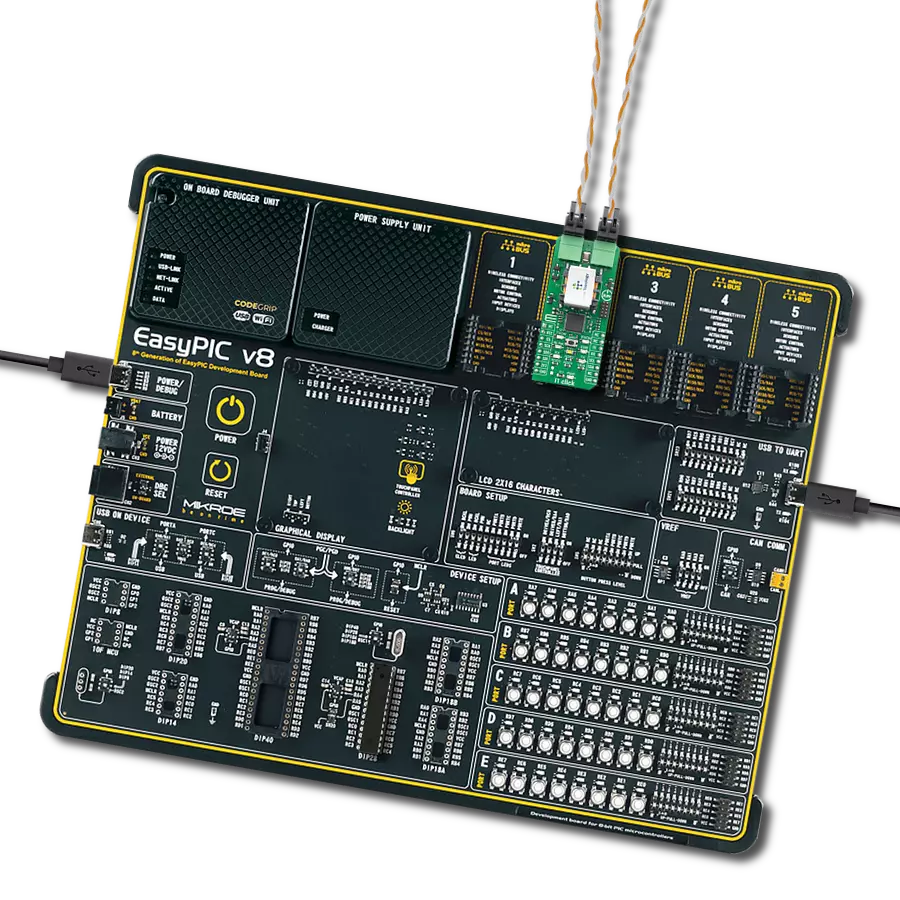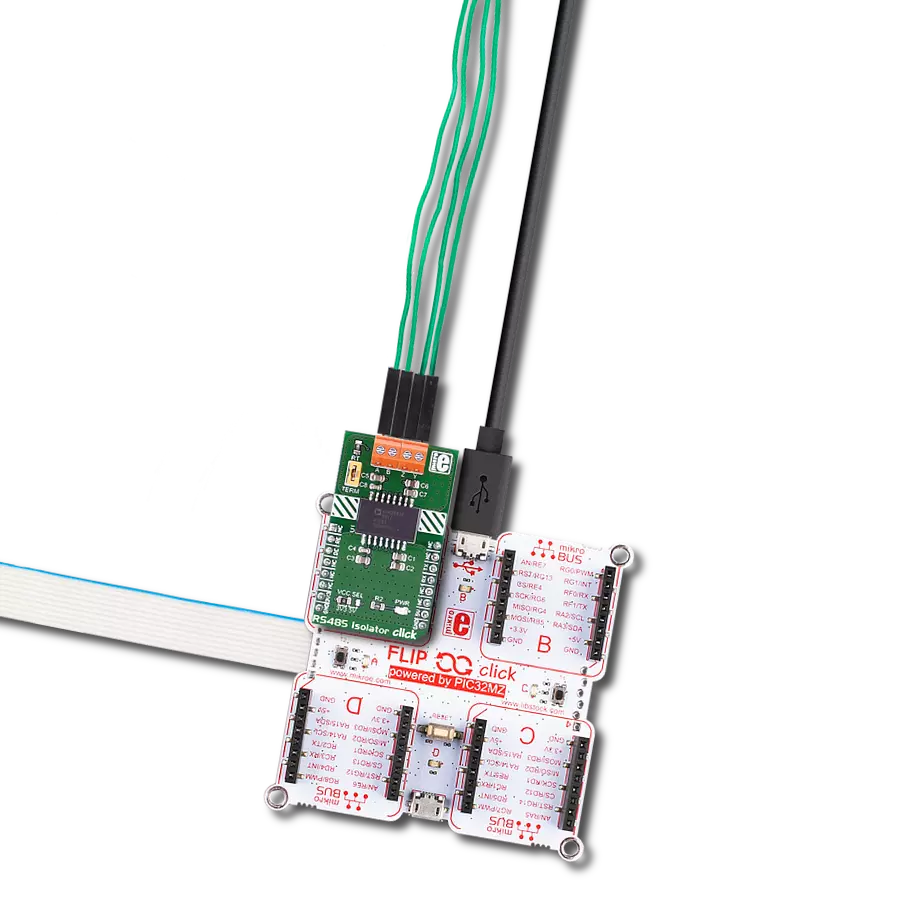Our full duplex RS485 transceiver ensures uninterrupted data communication, enabling seamless information flow in your network.
A
A
Hardware Overview
How does it work?
RS485 7 Click is based on the THVD1424, a flexible RS-485 transceiver from Texas Instruments for asynchronous data transmissions. The THVD1424 has two termination resistors of nominal 120Ω, one across Y/Z and another across A/B. Both termination resistors are turned on or off using the RET and TET pins of the mikroBUS™ socket, routed to the default positions of the PWM and INT pins of the mikroBUS™ socket. Both termination resistors can be enabled or disabled, independent of the state of the driver or receiver. Termination is OFF if the device is unpowered or in thermal shutdown. Internal ESD protection circuits protect the transceiver against Electrostatic Discharges (ESD) according to IEC 61000-4-2 of up to ±8kV (Contact Discharge), ±15kV (Air Gap Discharge), and against electrical-fast-transients (EFT) according to IEC 61000-4-4 of up to ±4kV. The THVD1424 RS-485 transceiver can be
used in half-duplex or full-duplex RS-485 networks by populating an onboard R5 resistor. Full duplex mode is the default state of this board (with unpopulated R5 resistor), where Y and Z terminal pins are driver output pins, and A/B pins are receiver input pins. By populating the R5 resistor, Half duplex mode is activated where the driver and receiver share the same bus pins (Y/Z pins are both driver and receiver pins). The device state is then controlled via two mikroBUS™ pins labeled DE and RE (driver and receiver turn on/off), routed to the default positions of the AN and RST pins of the mikroBUS™ socket. The THVD1424 can also be used in slow-speed or fast-speed RS485 networks by populating a slew rate control R10 resistor. By default, with the R10 resistor unpopulated, the maximum speed of operation for both driver and receiver is 20Mbps. By populating it, the maximum speed of operation for both driver
and receiver is 500kbps, where the receiver path has an additional noise filtering feature enabled. The THVD1424 also has built-in protection features such as supply undervoltage, bus short-circuit, and thermal shutdown. This Click board™ can operate with either 3.3V or 5V logic voltage levels selected via the VIO SEL jumper. This way, both 3.3V and 5V capable MCUs can use the communication lines properly. Also, the main power supply of the RS485 transceiver can be selected between 3.3V or 5V voltage levels selected via the VCC SEL jumper. The wide common-mode voltage range and low input leakage on bus pins make this Click board™ suitable for multi-point applications over long cable runs. Also, this Click board™ comes equipped with a library containing easy-to-use functions and an example code that can be used as a reference for further development.
Features overview
Development board
Nucleo-64 with STM32G474R MCU offers a cost-effective and adaptable platform for developers to explore new ideas and prototype their designs. This board harnesses the versatility of the STM32 microcontroller, enabling users to select the optimal balance of performance and power consumption for their projects. It accommodates the STM32 microcontroller in the LQFP64 package and includes essential components such as a user LED, which doubles as an ARDUINO® signal, alongside user and reset push-buttons, and a 32.768kHz crystal oscillator for precise timing operations. Designed with expansion and flexibility in mind, the Nucleo-64 board features an ARDUINO® Uno V3 expansion connector and ST morpho extension pin
headers, granting complete access to the STM32's I/Os for comprehensive project integration. Power supply options are adaptable, supporting ST-LINK USB VBUS or external power sources, ensuring adaptability in various development environments. The board also has an on-board ST-LINK debugger/programmer with USB re-enumeration capability, simplifying the programming and debugging process. Moreover, the board is designed to simplify advanced development with its external SMPS for efficient Vcore logic supply, support for USB Device full speed or USB SNK/UFP full speed, and built-in cryptographic features, enhancing both the power efficiency and security of projects. Additional connectivity is
provided through dedicated connectors for external SMPS experimentation, a USB connector for the ST-LINK, and a MIPI® debug connector, expanding the possibilities for hardware interfacing and experimentation. Developers will find extensive support through comprehensive free software libraries and examples, courtesy of the STM32Cube MCU Package. This, combined with compatibility with a wide array of Integrated Development Environments (IDEs), including IAR Embedded Workbench®, MDK-ARM, and STM32CubeIDE, ensures a smooth and efficient development experience, allowing users to fully leverage the capabilities of the Nucleo-64 board in their projects.
Microcontroller Overview
MCU Card / MCU
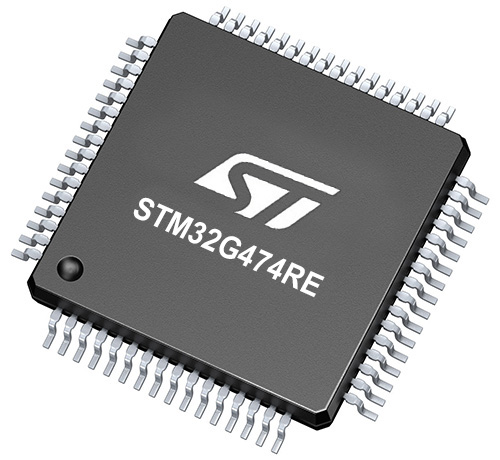
Architecture
ARM Cortex-M4
MCU Memory (KB)
512
Silicon Vendor
STMicroelectronics
Pin count
64
RAM (Bytes)
128k
You complete me!
Accessories
Click Shield for Nucleo-64 comes equipped with two proprietary mikroBUS™ sockets, allowing all the Click board™ devices to be interfaced with the STM32 Nucleo-64 board with no effort. This way, Mikroe allows its users to add any functionality from our ever-growing range of Click boards™, such as WiFi, GSM, GPS, Bluetooth, ZigBee, environmental sensors, LEDs, speech recognition, motor control, movement sensors, and many more. More than 1537 Click boards™, which can be stacked and integrated, are at your disposal. The STM32 Nucleo-64 boards are based on the microcontrollers in 64-pin packages, a 32-bit MCU with an ARM Cortex M4 processor operating at 84MHz, 512Kb Flash, and 96KB SRAM, divided into two regions where the top section represents the ST-Link/V2 debugger and programmer while the bottom section of the board is an actual development board. These boards are controlled and powered conveniently through a USB connection to program and efficiently debug the Nucleo-64 board out of the box, with an additional USB cable connected to the USB mini port on the board. Most of the STM32 microcontroller pins are brought to the IO pins on the left and right edge of the board, which are then connected to two existing mikroBUS™ sockets. This Click Shield also has several switches that perform functions such as selecting the logic levels of analog signals on mikroBUS™ sockets and selecting logic voltage levels of the mikroBUS™ sockets themselves. Besides, the user is offered the possibility of using any Click board™ with the help of existing bidirectional level-shifting voltage translators, regardless of whether the Click board™ operates at a 3.3V or 5V logic voltage level. Once you connect the STM32 Nucleo-64 board with our Click Shield for Nucleo-64, you can access hundreds of Click boards™, working with 3.3V or 5V logic voltage levels.
Used MCU Pins
mikroBUS™ mapper
Take a closer look
Click board™ Schematic

Step by step
Project assembly
Track your results in real time
Application Output
1. Application Output - In Debug mode, the 'Application Output' window enables real-time data monitoring, offering direct insight into execution results. Ensure proper data display by configuring the environment correctly using the provided tutorial.

2. UART Terminal - Use the UART Terminal to monitor data transmission via a USB to UART converter, allowing direct communication between the Click board™ and your development system. Configure the baud rate and other serial settings according to your project's requirements to ensure proper functionality. For step-by-step setup instructions, refer to the provided tutorial.

3. Plot Output - The Plot feature offers a powerful way to visualize real-time sensor data, enabling trend analysis, debugging, and comparison of multiple data points. To set it up correctly, follow the provided tutorial, which includes a step-by-step example of using the Plot feature to display Click board™ readings. To use the Plot feature in your code, use the function: plot(*insert_graph_name*, variable_name);. This is a general format, and it is up to the user to replace 'insert_graph_name' with the actual graph name and 'variable_name' with the parameter to be displayed.

Software Support
Library Description
This library contains API for RS485 7 Click driver.
Key functions:
rs4857_receiver_enable- RS485 7 enables the receiver function.rs4857_driver_enable- RS485 7 enables the driver function.
Open Source
Code example
The complete application code and a ready-to-use project are available through the NECTO Studio Package Manager for direct installation in the NECTO Studio. The application code can also be found on the MIKROE GitHub account.
/*!
* @file main.c
* @brief RS485 7 Click Example.
*
* # Description
* This example reads and processes data from RS485 7 Clicks.
* The library also includes a function for enabling/disabling
* the receiver or driver and data writing or reading.
*
* The demo application is composed of two sections :
*
* ## Application Init
* Initializes driver performs wake-up module and enables the selected mode.
*
* ## Application Task
* This example demonstrates the use of the RS485 7 Click board™.
* The app sends a "MikroE" message, reads the received data and parses it.
* Results are being sent to the UART Terminal, where you can track their changes.
*
* ## Additional Function
* - static void rs4857_clear_app_buf ( void )
* - static err_t rs4857_process ( void )
*
* @note
* Operation Mode: Full duplex.
* Transmitter: Y and Z.
* Receiver: A and B.
* Wire connection: Y-A, Z-B.
*
* @author Nenad Filipovic
*
*/
#include "board.h"
#include "log.h"
#include "rs4857.h"
#define DEMO_MESSAGE "\r\nMikroE\r\n"
#define PROCESS_BUFFER_SIZE 200
static rs4857_t rs4857;
static log_t logger;
static char app_buf[ PROCESS_BUFFER_SIZE ] = { 0 };
static int32_t app_buf_len = 0;
/**
* @brief RS485 7 clearing application buffer.
* @details This function clears memory of application buffer and reset its length and counter.
* @note None.
*/
static void rs4857_clear_app_buf ( void );
/**
* @brief RS485 7 data reading function.
* @details This function reads data from device and concatenates data to application buffer.
* @return @li @c 0 - Read some data.
* @li @c -1 - Nothing is read.
* @li @c -2 - Application buffer overflow.
* See #err_t definition for detailed explanation.
* @note None.
*/
static err_t rs4857_process ( void );
void application_init ( void )
{
log_cfg_t log_cfg; /**< Logger config object. */
rs4857_cfg_t rs4857_cfg; /**< Click config object. */
/**
* Logger initialization.
* Default baud rate: 115200
* Default log level: LOG_LEVEL_DEBUG
* @note If USB_UART_RX and USB_UART_TX
* are defined as HAL_PIN_NC, you will
* need to define them manually for log to work.
* See @b LOG_MAP_USB_UART macro definition for detailed explanation.
*/
LOG_MAP_USB_UART( log_cfg );
log_init( &logger, &log_cfg );
log_info( &logger, " Application Init " );
// Click initialization.
rs4857_cfg_setup( &rs4857_cfg );
RS4857_MAP_MIKROBUS( rs4857_cfg, MIKROBUS_1 );
if ( UART_ERROR == rs4857_init( &rs4857, &rs4857_cfg ) )
{
log_error( &logger, " Communication init." );
for ( ; ; );
}
log_info( &logger, " Application Task " );
app_buf_len = 0;
rs4857_termination_xy_enable( &rs4857 );
rs4857_termination_ab_enable( &rs4857 );
rs4857_receiver_enable( &rs4857 );
rs4857_driver_enable( &rs4857 );
Delay_ms ( 100 );
}
void application_task ( void )
{
if ( rs4857_generic_write( &rs4857, DEMO_MESSAGE, 10 ) )
{
rs4857_process( );
if ( app_buf_len > 0 )
{
log_printf( &logger, "%s", app_buf );
rs4857_clear_app_buf( );
}
}
Delay_ms ( 1000 );
Delay_ms ( 1000 );
}
int main ( void )
{
/* Do not remove this line or clock might not be set correctly. */
#ifdef PREINIT_SUPPORTED
preinit();
#endif
application_init( );
for ( ; ; )
{
application_task( );
}
return 0;
}
static void rs4857_clear_app_buf ( void )
{
memset( app_buf, 0, app_buf_len );
app_buf_len = 0;
}
static err_t rs4857_process ( void )
{
int32_t rx_size;
char rx_buf[ PROCESS_BUFFER_SIZE ] = { 0 };
rx_size = rs4857_generic_read( &rs4857, rx_buf, PROCESS_BUFFER_SIZE );
if ( rx_size > 0 )
{
int32_t buf_cnt = 0;
if ( ( app_buf_len + rx_size ) > PROCESS_BUFFER_SIZE )
{
rs4857_clear_app_buf( );
return RS4857_ERROR;
}
else
{
buf_cnt = app_buf_len;
app_buf_len += rx_size;
}
for ( int32_t rx_cnt = 0; rx_cnt < rx_size; rx_cnt++ )
{
if ( rx_buf[ rx_cnt ] != 0 )
{
app_buf[ ( buf_cnt + rx_cnt ) ] = rx_buf[ rx_cnt ];
}
else
{
app_buf_len--;
buf_cnt--;
}
}
return RS4857_OK;
}
return RS4857_ERROR;
}
// ------------------------------------------------------------------------ END
Additional Support
Resources
Category:RS485





















